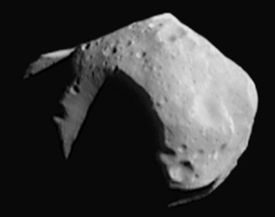253 Mathilde

253 Mathilde as seen by NEAR in 1997
|
|
| Discovery | |
|---|---|
| Discovered by | Johann Palisa |
| Discovery date | 12 November 1885 |
| Designations | |
| Pronunciation | /məˈtɪldə/ |
|
Named after
|
Mathilde Loewy |
| 1949 OL1, A915 TN | |
| Main belt | |
| Orbital characteristics | |
| Epoch 31 July 2016 (JD 2457600.5) | |
| Uncertainty parameter 0 | |
| Observation arc | 130.38 yr (47622 d) |
| Aphelion | 3.35003411 AU (501.157970 Gm) |
| Perihelion | 1.9467702 AU (291.23268 Gm) |
| 2.648402147 AU (396.1953219 Gm) | |
| Eccentricity | 0.26492652 |
| 4.31 yr (1574.3 d) | |
|
Average orbital speed
|
17.98 km/s |
| 170.584348° | |
| 0° 13m 43.248s / day | |
| Inclination | 6.7427122° |
| 179.58936° | |
| 157.39642° | |
| Earth MOID | 0.939032 AU (140.4772 Gm) |
| Jupiter MOID | 2.06073 AU (308.281 Gm) |
| Jupiter Tisserand parameter | 3.331 |
| Physical characteristics | |
| Dimensions | 52.8 km (66×48×46 km) |
| Mass | 1.033(±0.044)×1017 kg |
|
Mean density
|
1.3 g/cm³ |
|
Equatorial surface gravity
|
0.00989 m/s² |
|
Equatorial escape velocity
|
22.9 m/s |
| 417.7 h (17.40 d) 17.406±0.010 d (17 d 9 h 45 min) |
|
| 0.0436±0.004 | |
| Temperature | ≈ 174K |
| Cb | |
| 10.3 | |
253 Mathilde /məˈtɪldə/ is a main-belt asteroid about 50 km in diameter that was discovered by Johann Palisa in 1885. It has a relatively elliptical orbit that requires more than four years to circle the Sun. This asteroid has an unusually slow rate of rotation, requiring 17.4 days to complete a 360° about its axis. It is a primitive C-type asteroid, which means the surface has a high proportion of carbon; giving it a dark surface that reflects only 4% of the light that falls on it.
This asteroid was visited by the NEAR Shoemaker spacecraft during June 1997, on its way to asteroid 433 Eros. During the flyby, the spacecraft imaged a hemisphere of the asteroid, revealing many large craters that have gouged out depressions in the surface. It was the first C-type asteroid to be explored and, until 21 Lutetia was visited in 2010, it was the largest asteroid to be visited by a spacecraft.
In 1880, Johann Palisa, the director of the Austrian Naval Observatory, was offered a position as an assistant at the newly completed Vienna Observatory. Although the job represented a demotion for Johann, it gave him access to the new 27-inch (690 mm) refractor, the largest telescope in the world at that time. By this point Johann had already discovered 27 asteroids, and he would employ the Vienna 27-inch (690 mm) and 12-inch (300 mm) instruments to find an additional 94 asteroids before he retired.
Among his discoveries was the asteroid 253 Mathilde, found on November 12, 1885. The initial orbital elements of the asteroid were then computed by V. A. Lebeuf, another Austrian astronomer working at the observatory. The name of the asteroid was suggested by Lebeuf, after Mathilde, the wife of Moritz Loewy—who was the vice director of the Paris Observatory.
...
Wikipedia
